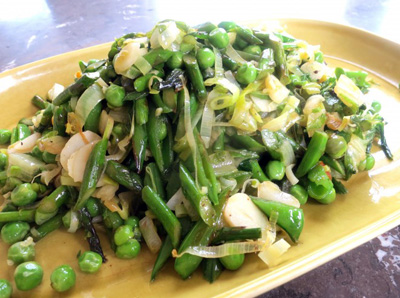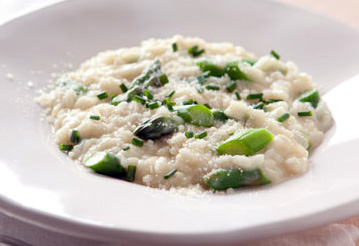 Los Angeles is shedding its winter coat, the birds are singing; Spring has boinged in like Zebedee. The farmers markets are jam-packed with citrus, strawberries, golden beets and asparagus.
Los Angeles is shedding its winter coat, the birds are singing; Spring has boinged in like Zebedee. The farmers markets are jam-packed with citrus, strawberries, golden beets and asparagus.
I got four bunches of gorgeous, small, round radishes for $2, two bunches of sweet peas for $4 and tiny beets in every shade of pink and gold.
Fifteen old friends came to supper last night, a Clein + Feldman reunion. It was, of course, just as if twenty years hadn't gone by: everyone looked the same, sounded the same, but maybe wiser, greeting each other as if we'd been in the office together just yesterday.

 This is what spring looks like. Truly. So why not make a dish that takes the best of those green, grassy, sweet flavors, adds garlic, great olive oil and a hit of salt and serve it up in one dish? The subtle beauty of all these colors of green tangled together help us understand the idea of renewal inherent in the spring holiday celebrations of Easter or Passover.
This is what spring looks like. Truly. So why not make a dish that takes the best of those green, grassy, sweet flavors, adds garlic, great olive oil and a hit of salt and serve it up in one dish? The subtle beauty of all these colors of green tangled together help us understand the idea of renewal inherent in the spring holiday celebrations of Easter or Passover. One day it's pouring rain and the next it's sunny and bright. Trees are already blooming with cherry blossoms, the delicate pink petals sometimes getting washed away in a sudden downpour. The hills all around the Bay Area are green and lush. And in the store you can find fresh strawberries, artichokes and asparagus.
One day it's pouring rain and the next it's sunny and bright. Trees are already blooming with cherry blossoms, the delicate pink petals sometimes getting washed away in a sudden downpour. The hills all around the Bay Area are green and lush. And in the store you can find fresh strawberries, artichokes and asparagus. What do Jerusalem artichokes, horseradish and dandelion greens have in common? You'll never guess. Each has a name that is an English version of a foreign name. The Jerusalem artichoke is a variety of sunflower, and the name is derived from "girasole" which means sunflower in Italian. Horseradish is "meerrettich" in German and because "meer" sounds like "mare" the English called it horseradish. Dandelion comes from the French "dent de lion" or lion's tooth, in reference to the jagged leaves of this bitter yet tasty weed.
What do Jerusalem artichokes, horseradish and dandelion greens have in common? You'll never guess. Each has a name that is an English version of a foreign name. The Jerusalem artichoke is a variety of sunflower, and the name is derived from "girasole" which means sunflower in Italian. Horseradish is "meerrettich" in German and because "meer" sounds like "mare" the English called it horseradish. Dandelion comes from the French "dent de lion" or lion's tooth, in reference to the jagged leaves of this bitter yet tasty weed. I love herbs. I grow them, I cook with them, I eat them and sometimes just smell them for instant links to memories and tastes. Growing up in Hawkinsville as a child, our farm provided space a plenty for me to dabble in herb cultivation. It was there, on our farm, that I first learned what organic gardening was, though I did not know my “organic gardening” was “organic gardening.” I knew our cows ate our grass, drank our spring water, and breathed our surrounding air. So, I knew, somewhat instinctively, that their manure was just good… basic, natural fertilizer – the byproduct of the cows’ natural digestion. What better fertilizer, compost amendment, and soil conditioner could there be?
I love herbs. I grow them, I cook with them, I eat them and sometimes just smell them for instant links to memories and tastes. Growing up in Hawkinsville as a child, our farm provided space a plenty for me to dabble in herb cultivation. It was there, on our farm, that I first learned what organic gardening was, though I did not know my “organic gardening” was “organic gardening.” I knew our cows ate our grass, drank our spring water, and breathed our surrounding air. So, I knew, somewhat instinctively, that their manure was just good… basic, natural fertilizer – the byproduct of the cows’ natural digestion. What better fertilizer, compost amendment, and soil conditioner could there be?